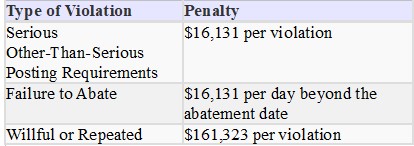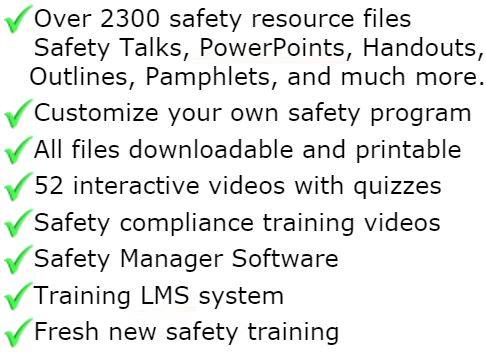
Construction Site Employee Safety Training Manual
This is a sample or partial document
Download the full customizable and printable version
(Enter your Company Name)
NOTE: This sample program is provided to assist you as an employer in developing a program tailored to your own operation. We encourage employers to copy, expand, modify and change the sample as necessary to accomplish this.
COMPANY POLICY LETTER
SAFETY AND HEALTH POLICY FOR (Enter your Company Name)
The purpose of this policy is to develop a high standard of safety throughout all operations of
(Enter your Company Name)
We believe that each employee has the right to derive personal satisfaction from his/her job and the prevention of occupational injury or illness is of such consequence to this belief that it will be given top priority at all times.
It is our intention here at (Enter your Company Name) to initiate and maintain complete accident prevention and safety training programs. Each individual from top management to the working person is responsible for the safety and health of those persons in their charge and coworkers around them. By accepting mutual responsibility to operate safely, we will all contribute to the well being of personnel.
Construction Safety Program Outline
(Enter your Company Name)
Safety Orientation: Each employee will be given a safety orientation by (Add name or title of person who will provide the initial safety orientation) when first hired. The orientation will cover the following items:
ADD ->A description of the accident prevention program:
· We have a formal written accident prevention program. It consists of this safety orientation, safety meetings, and Self-inspections.
· We also have basic safety rules that all employees must follow. They are:
· Never do anything that is unsafe in order to get the job done. If a job is unsafe, report it to your supervisor or foreman. We will find a safer way to do that job.
· Do not remove or disable any safety device! Keep guards in place at all times on operating machinery.
· Never operate a piece of equipment unless you have been trained and are authorized.
· Use your personal protective equipment whenever it is required.
· Obey all safety warning signs.
· Working under the influence of alcohol or illegal drugs or using them at work is prohibited.
· Do not bring firearms or explosives onto company property.
· Horseplay, running and fighting are prohibited
· Clean up spills immediately. Replace all tools and supplies after use. Do not allow scraps to accumulate where they will become a hazard. Good housekeeping helps prevent accidents.
· (Add any other basic safety rules that apply to your company. Delete any from the above list that do not apply to your business.)
ADD ->A description of the accident prevention program:
· If you are injured or become ill on the job, report this to (Add name or title of person).
· We require all supervisors and/or foremen to have first-aid/CPR training..
• We have first aid qualified workers here but we do not have “designated” first-aiders. First aid at the job site is done on a Good Samaritan basis.
· If first aid trained personnel are involved in a situation involving blood, they should:
· Avoid skin contact with blood/other potentially infectious materials by letting the victim help as much as possible, and by using gloves provided in the first aid kit.
· Remove clothing, etc. with blood on it after rendering help.
· Wash thoroughly with soap and water to remove blood. A 10% chlorine bleach solution is good for disinfecting areas contaminated with blood (spills, etc.).
· Report such first aid incidents within the shift to supervisors (time, date, blood presence, exposure, names of others helping).
· First aid kit locations at this jobsite include:
• (Add Location(s))
Temperature Extremes
Workers subjected to temperature extremes, radiant heat, humidity, or air velocity combinations which, over a period of time, may produce physical illness. Protection by use of adequate controls, methods or procedures, or use of protective clothing will be provided to employees working in these conditions. Excessive exposure to heat is referred to as heat stress and excessive exposure to cold is referred to as cold stress.
Heat related illness (HRI) and cold-induced illnesses (Hypothermia/frostbite) are well known, recognized workplace hazards. All work operations involving exposure to temperature extremes, either humidity/heat extremes or cold extremes have the potential for inducing heat stress and heat related illnesses or cold stress resulting in frostbite or hypothermia, therefore, (Add Company Name) has developed a policy to address these issues. All employees will receive training relating to the causes and effects, as well as the personal and environmental factors that may lead to temperature extreme related illnesses. Each employee will be provided with training and materials that include but are not limited to:
• The chosen method or methods to assess the risk for HRI or cold stress.
• A section covering training elements to provide employees information on what the employer will do when working in extreme weather conditions.
• A section on first aid including how to identify HRI symptoms and cold stress systems. The proper first aid application for an individual that is suffering from HRI or cold weather illness, and procedures for summoning medical aid personnel.
• A section identifying where and how adequate drinking water will be supplied.
ADD->What to do in an emergency including how to exit the workplace:
· An evacuation map for the building is posted (Add location of evacuation map if you have one or delete this sentence). It shows the location of exits, fire extinguishers, first aid kits, and where to assemble outside.
Fire Emergency
· A fire extinguisher or fire extinguishers will be covered as part of this orientation. (Add information about how fire emergencies will be handled in your business.)
· If you discover a fire: Tell another person immediately. Call or have them call 911 and a supervisor.
· If the fire is small (such as a wastebasket fire) and there is minimal smoke, you may try to put it out with a fire extinguisher.
· If the fire grows or there is thick smoke, do not continue to fight the fire.
· Tell other employees in the area to evacuate.
· Go to the designated assembly point outside the building.
Add-> other emergency procedures
Identification of hazardous chemicals used at this location
· Safe use and emergency actions to take following an accidental exposure.
· We use a limited number of chemicals. You will receive a separate orientation as part of our chemical hazard communication program on the hazards of these chemicals before you work with them or work in an area where they are used.
ADD->Use and care of required personal protective equipment (PPE):
· Some tasks in our company require an employee to wear PPE to protect against injury.
· You will be instructed by (Add name or title of person who will instruct employees in the use and care of PPE) using the manufacturer’s instructions on how to use and care for these PPE.
On-the-job training about what you need to know to perform the job safely:
· Before you are first assigned a task, (Add name or title of person who will conduct on-the-job training for new employees) will show you what to do along with safety instructions and required PPE.
· We have established safety rules and personal protective equipment (PPE) requirements based upon a hazard assessment for each task.
· Do not use equipment or attempt to do any of these tasks until you have received the required training and PPE.
Safety Meetings and Self-Inspections
· Employee Safety Meetings
· At the beginning of each job and at least weekly thereafter.
· Review of any walk-around safety inspections conducted since the last safety meeting.
· Review of any citation to assist in correction of hazards.
· Evaluation of any accident investigations conducted since the last meetings to determine if the cause of the unsafe acts or unsafe conditions involved were properly identified and corrected.
· Document attendance and other subjects discussed.
· Maintain records for one year.
· Self-inspections
· At the beginning of each job, and at least weekly thereafter.
· Include one member of management and one employee, elected by the employees, as their authorized representative.
· Document walk-around safety inspection.
· Maintain records until the completion of the job.
Safety Disciplinary Policy
(Enter your Company Name) believes that a safety and health Accident Prevention Program is unenforceable without some type of disciplinary policy. Our company believes that in order to maintain a safe and healthful workplace, the employees must be cognizant and aware of all company, State, and Federal safety and health regulations as they apply to the specific job duties required. The following disciplinary policy is in effect and will be applied to all safety and health violations.
The following steps will be followed unless the seriousness of the violation would dictate going directly to Step 2 or Step 3.
1. A first time violation will be discussed orally between company supervision and the employee. This will be done as soon as possible.
2. A second time offense will be followed up in written form and a copy of this written documentation will be entered into the employee’s personnel folder. Time off without pay (3 day minimum).
3. A third time violation will result in termination.
If an employee of this company knowingly and willingly violates any of the safety rules or procedures, or puts his/her self in an imminent danger situation, the employee will be immediately discharged.
3. A third time violation will result in termination.
General Safe Work Practices for Construction
Personal Protective Equipment
• Suitable clothing must be worn; long pants, at least short-sleeved shirts and adequate foot wear.
• Hard hats, safety glasses or goggles must be used when a potential hazard exists.
(Safety glasses must be ANSI Z87 or Z87.1 approved).
• Hearing protection (earplugs or earmuffs) must be used in high noise areas.
Housekeeping
• Always store materials in a safe manner. Tie down or support materials if necessary to prevent falling, rolling, or shifting.
• Shavings, dust scraps, oil or grease should not be allowed to accumulate. Good housekeeping is a part of the job.
• Trash piles must be removed as soon as possible. Trash is a safety and fire hazard.
• Immediately remove all loose materials from stairs, walkways, ramps, platforms, etc.
• Do not block aisles, traffic lanes, fire exits, gangways, or stairs.
Other general safe work practices
• Avoid shortcuts – use ramps, stairs, walkways, ladders, etc.
• Do not remove, deface or destroy any warning, danger sign, or barricade, or interfere with any form of accident prevention device or practice provided for your use or that is being used by other workers.
• Get help with heavy or bulky materials to avoid injury to yourself or damage to material.
• Do not use tools with split, broken, or loose handles, or burred or mushroomed heads. Keep cutting tools sharp and carry all tools in a container.
• Know the correct use of hand and power tools. Use the right tool for the job.
Fall protection
• Fall hazards of 10 feet or more will be outlined and addressed in our jobsite fall protection work plan.
• Fall hazards of less than 10 feet will be protected by covers, guardrails or other methods and will be addressed in our self-inspections and safety meetings.
• Standard guardrails must be erected around all floor openings and open-sided surfaces. Contact your supervisor for the correct specifications.
Electrical
• Ground-fault circuit interrupters (GFCI) will be used when ever possible.
• Electric cords will be inspected daily and repaired or replaced as necessary.
• Do not operate any power tool or equipment unless you are trained in its operation.
• Use tools only for their designed purpose.
Ladder safety
• Inspect before use for physical defects.
• Ladders are not to be painted except for numbering purposes.
• Do not use ladders for skids, braces, workbenches, or any purpose other than climbing.
• When you are ascending or descending a ladder, do not carry objects that will prevent you from grasping the ladder with both hands.
• Always face the ladder when ascending and descending..
• If you must place a ladder over a doorway, barricade the door to prevent its use and post a warning sign.
• Only one person is allowed on a ladder at a time.
• Do not jump from a ladder when descending.
• All joints between steps, rungs, and side rails must be tight.
• Safety feet must be in good working order and in place.
• Rungs must be free of grease and/or oil.

GET INSTANT ACCESS
to THE MEMBERS LIBRARY
Safety materials created by safety professionals.
Access to the Safety Manager software.
Wide variety of safety videos and courses.
**Brand New** Safety Training Management System
Pre-Made Safety Materials Ready For Use
Created by experienced safety professionals & risk consultants. Saving you time, money, and risk of injuries.
95% of the work already done.
Below are the maximum penalty amounts, with the annual adjustment for inflation, that may be assessed after Jan. 15, 2024. (See OSHA Memo, Jan. 8, 2024).

**New OSHA HEAT 90 DAY**
>>Download Free HERE<<
**New 2024 OSHA 300 Form**
>>Download Free HERE<<
**Brand New**
Free with full membership subscription
Training LMS System
Ask The Safety Consultant
Safety Equipment Deal Finder

“SafetyInfo.com is the first go-to website for safety professionals and companies to use in establishing a solid safety program"
-Mike McKenzie, Certified Safety & Health Manager (CSHM), McSafety Solutions™
Note: You must have a full subscription to the Safety Library in order to use this material. Any use outside of your organization, for resell, or without an active membership is strictly prohibited and may result in prosecution under copyright infringement laws. Please contact us first, if you would be interested in reselling or using our materials for reproduction.
Inside the Members Library
Topic Index
Accident Prevention
Air Quality
Asbestos
Bloodborne Pathogens
Boilers
Chemical Safety
Compressed Gas
Confined Space
Construction
Construction Worksite
Cranes & Slings
Driver / Fleet Safety
Drug Free Workplace
Electrical
Emergency Management
Engineering Safety
Environmental
Equipment
Ergonomics
Fall Protection
Fire Safety & Prevention
First Aid
Flammable Materials
Forklifts
Hazard Communication
Hazardous Materials
Hearing Protection
Heat Stress
Hot Work
Housekeeping
Job Safety Analysis
Laboratory
Ladders
Lead
Lockout-Tagout
Machinery & Equipment
Material Handling
MSDS (SDS)
Medical & First Aid
Occupational Health
Office Safety
Off the Job Safety
Personal Protection
Process Safety
Record Keeping
Respiratory Protection
Silica Safety
Rules & Policies
Signs & Labels
Slips, Trips & Fall
Training
Terrorism Programs
Tool Safety
Vehicle & Driver
Violence Programs
Welding & Hot Work
Training Videos
Library Index
Training Materials
Videos/Courses
Talks
Articles
PowerPoint
Handouts
Training Overheads
Quizzes
Supervisor Briefs
Management Briefs
Safety Sessions
2 Minute OSHA Safety Talks
Pamphlets
First Aid Training
Supervisor Training
Hazardous Materials
Bomb Threat
Crossword Puzzles
Biological Agents
Forms & Documents
Forms
Checklists
Audit Guides
Inspections Guides
Signs & Labels
Environmental Audit Guides
Recordkeeping - OSHA 300
Sign & Label Maker
Safety Management Resources
Safety Manuals/Written Programs
Ergonomic Programs
Emergency Plans
Process Safety Management
Construction Safety
Occupational Health
Environmental
Topic Sheets
DOT Fleet-Driver
Hazardous Materials
Chemical Safety
Drug Free Workplace
Terrorism Programs
Development Guides
Safety Manager Software
Safety References & Graphics
Technical Safety Information
Posters
Topic & Fact Sheets
Development Information
Job Specific Safety Rules
Terrorism
Calculators
Safety Comic Strips
New Safety Training System
Schedule and train your employees with our materials. Add unlimited amount of employees. Record all progress and issue certificates. For group and individual training sessions.

